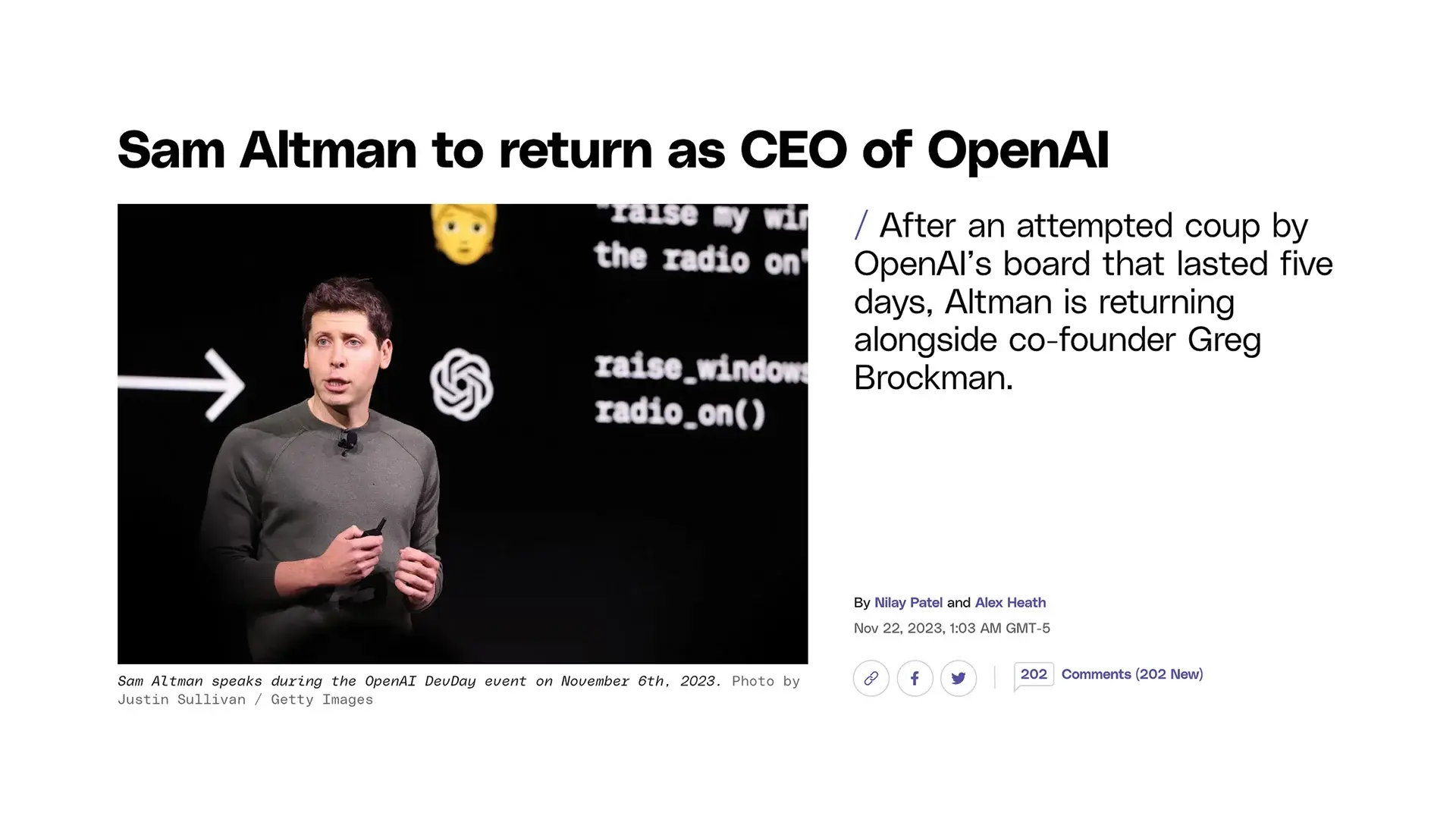Back to News
The Rollercoaster Week at OpenAI: A Detailed Examination of Sam Altman's Ouster and Comeback
November 23 2023

Source: The Verge
In the fast-paced world of artificial intelligence, OpenAI has emerged as a key player, pushing the boundaries of technology while grappling with ethical dilemmas. At the heart of this organization is Sam Altman, a figure synonymous with innovation and controversy. The events of one tumultuous week at OpenAI not only highlight the challenges facing the AI industry but also underscore the complexities of leadership in a rapidly evolving technological landscape.
The Genesis of OpenAI
OpenAI's story begins with an ambitious vision, born out of a commitment to ethical AI development. Founded as a nonprofit, its inception was a response to growing concerns about AI's potential misuse. This was not just another tech startup; it was a collective of AI researchers and enthusiasts determined to steer AI towards benefiting humanity, avoiding paths that could lead to monopolistic control or military applications.
From its early days, OpenAI set itself apart in the global AI community. Its open-source ethos and collaborative approach to research fostered an environment where innovation thrived. This approach attracted top minds in AI, creating a hotbed for breakthroughs in natural language processing and machine learning. OpenAI’s projects, like the development of GPT (Generative Pre-trained Transformer) models, quickly grabbed headlines, showcasing the organization's technical prowess.
Sam Altman's Influence and OpenAI's Strategic Shift
The arrival of Sam Altman at OpenAI marked a pivotal shift. Known for his successful stint at Y Combinator, Altman brought entrepreneurial zest coupled with a deep understanding of the tech landscape. Under his leadership, OpenAI began to explore the intersection of ethical AI and commercial viability. This phase saw OpenAI forging significant partnerships, notably with Microsoft, which injected substantial investment and resources into the organization. This move towards a hybrid model of nonprofit and for-profit was both a strategic necessity and a topic of internal debate, reflecting the complexities of scaling AI innovations while maintaining ethical integrity.
OpenAI's Board and the Balancing Act
The role of OpenAI's board, a blend of industry experts, scientists, and ethicists, evolved as the organization grew. Tasked with navigating the challenges of advancing AI technology and upholding ethical standards, the board's decisions often reflected the tension between these two poles. As AI technology advanced, pushing ethical boundaries and raising safety concerns, the board's role in guiding OpenAI's direction became even more critical.
The Prelude to Controversy
Discovery of Q*: The initial spark for the crisis was a breakthrough in AI research within OpenAI, referred to as Q*. This development was seen as a significant step toward achieving artificial general intelligence, a long-standing goal in AI research. However, it also raised serious concerns about the pace of AI development and the adequacy of existing safety measures.
The Shocking Dismissal of Altman
Decision to Fire Altman: In a dramatic move, Altman was fired from his position as CEO. This decision was a culmination of growing internal tensions over the direction of AI development at OpenAI, particularly around the rapid deployment of new AI technologies versus a more measured, safety-first approach.
Microsoft's Involvement and the Employee Revolt
Microsoft's Stake: As a key investor and partner in OpenAI, Microsoft had a significant interest in the organization's direction and leadership stability. The tech giant's investment in OpenAI was part of its broader strategy to stay at the forefront of the AI revolution.
The Staff Uprising: Altman's firing triggered an unprecedented reaction among OpenAI employees. The threat of mass resignations and potential defections to Microsoft signaled a deep loyalty to Altman's vision and leadership style. This employee unrest was a powerful demonstration of the workforce's influence on corporate decisions in the tech industry.
The Dramatic Reversal: Altman's Reinstatement
Behind-the-Scenes Dynamics: In the days following Altman's dismissal, intense negotiations and discussions unfolded. These talks involved balancing the concerns of various stakeholders, including Microsoft, OpenAI's board, and its employees.
Altman Returns: The decision to reinstate Altman was a remarkable turnaround. It reflected not only the strength of employee sentiment but also the complexities of managing an organization at the cutting edge of technology, where leadership choices have far-reaching implications.
The Aftermath: Reflecting on OpenAI's Direction
Ethical AI Development Revisited: The incident brought to the forefront the ongoing debate over ethical AI development. It underscored the need for a careful balance between innovation and the responsible stewardship of technology that could have profound societal impacts.
Commercial Pressures and Ethical Commitments: OpenAI's evolution towards a more commercial model under Altman’s leadership was a contentious issue. This shift raised questions about the potential influence of profit motives on AI research and development, particularly in light of Microsoft's involvement and the broader implications for the AI industry.
The whirlwind events surrounding Sam Altman at OpenAI are a microcosm of the broader challenges and debates in the AI industry. They highlight the delicate interplay between technological advancement, ethical responsibility, corporate interests, and leadership dynamics. As AI continues to reshape various facets of our world, the lessons from OpenAI's eventful week offer valuable insights into the future of AI governance and the role of leadership in steering this powerful technology towards beneficial outcomes
Share socially